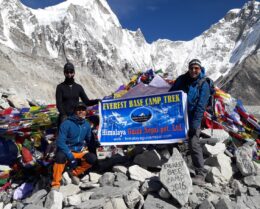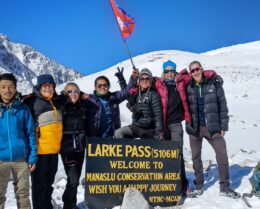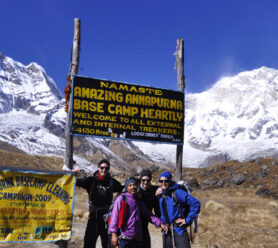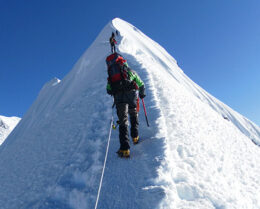Down Jacket vs. Padded Jacket: What’s the Best Choice for Trekkers?
PUBLISHED ON 24 August, 2023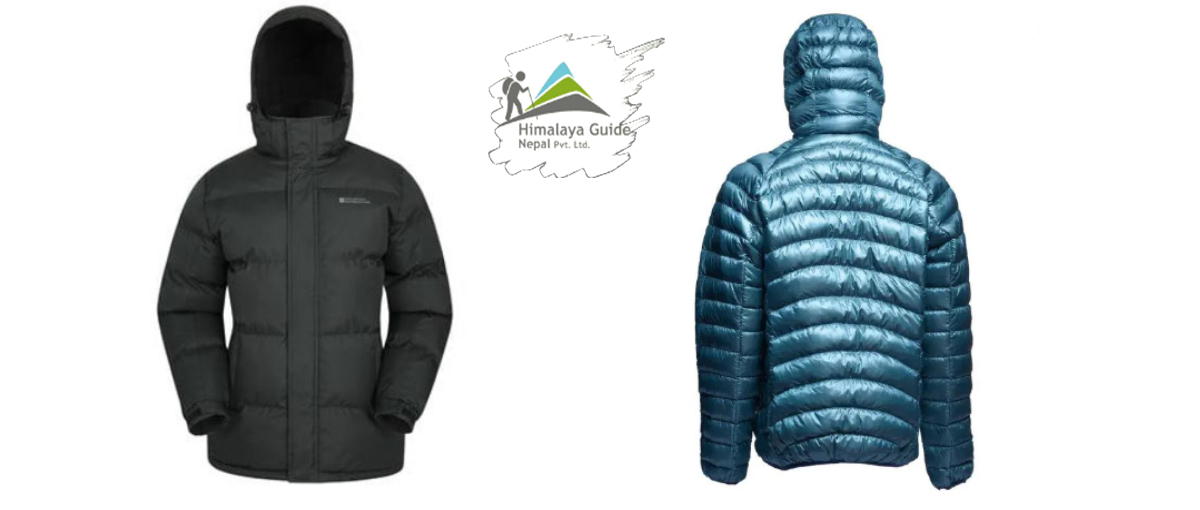
When it comes to trekking in cold and challenging environments, having the right gear is essential. Among the most important pieces of gear for your trekking adventure is your outerwear. Jackets are an essential part of this gear, providing warmth, protection, and mobility. In this comparison, we’ll explore the differences between a down jacket and a padded jacket.
We’ll examine factors like warmth-to-weight ratios, water resistance, shell fabrics, and more to help you make an informed decision for your next trekking adventure. To get started, let’s take a look at the context of Nepalese geography and weather along most of the trekking routes.
Understanding Down Jacket vs. Padded Jacket
Nepal, with its majestic peaks and awe-inspiring landscapes, serves as a sanctuary for mountaineers and adventurers worldwide.
From the iconic Everest Base Camp trek to daring summit endeavors, the Himalayas present unique challenges and environmental conditions that necessitate meticulous gear selection.
When facing the Nepalese mountains, the decision between a down jacket and a padded jacket carries immense significance. Let’s explore how the insights derived from comparing these jackets align with the demands of Nepalese mountaineering.
Understanding Warmth-to-Weight Ratios: The Ultimate Balancing Act
For trekkers, a pivotal consideration revolves around the warmth-to-weight ratio of their jackets. Down jackets have long been venerated for their exceptional warmth-to-weight ratios. They employ goose or duck-down insulation to capture air, creating an insulating barrier that delivers substantial warmth without introducing excessive weight.
This has endeared them to ultra-light enthusiasts and proponents of minimalism. Padded jackets, conversely, also offer commendable warmth-to-weight ratios, courtesy of advancements in synthetic insulation technology.
Modern synthetic insulating materials are lightweight and mimic the isolative properties of down, all while retaining their warmth even when damp. These jackets present a compelling choice for trekkers who may encounter moist conditions.
Water Resistance: Battle of the Elements
The ability to stay warm in damp conditions hinges on water resistance. Down jackets excel in providing warmth but can falter when exposed to moisture. Traditional down insulation tends to lose its loft and insulating capabilities when wet.
However, numerous high-quality down jackets now incorporate a durable water-repellent (DWR) treatment on the outer shell fabric to offer some level of defense against light rain and moisture.
Padded jackets, featuring synthetic insulation, hold an edge in wet conditions. Synthetic insulation materials excel at retaining warmth even when confronted with dampness. This positions padded jackets as a sound choice for trekkers who might encounter unexpected rain or humid environments.
Shell Fabrics: The First Line of Defense
The selection of shell material significantly influences a jacket’s performance across various conditions. Down jackets typically utilize lightweight yet sturdy shell fabrics that prevent the down from escaping while also providing some protection against wind and mild precipitation.
These jackets prove ideal for cold, arid environments, delivering remarkable warmth without sacrificing weight. Padded jackets offer a spectrum of shell materials. Some models prioritize breathability and flexibility, making them suitable for active trekking.
Others incorporate robust waterproof and windproof materials, effectively merging puffer jacket insulation with rain jacket protection. Brands such as Arc’teryx Cerium LT and Mountain Hardwear Ghost are renowned for their premium shell materials, striking a balance between safeguarding and comfort.
The Fill Power Factor: 800 Fill Power and Beyond
A substantial gauge of a down jacket’s quality resides in its fill power. Fill power denotes the volume that one ounce of down can occupy in cubic inches. Elevated fill power signifies superior down quality with heightened insulating potential. Many top-tier down jackets boast fill power ratings of 800 or higher, equating to exceptional warmth without unwarranted bulk.
For trekkers prioritizing warmth above all else, a down jacket with substantial fill power can be transformative. However, it’s worth acknowledging that elevated fill power often accompanies a loftier price tag.
Consequently, if you seek a more budget-conscious alternative, down jackets with marginally lower fill power can still deliver ample warmth.
Ethical Considerations: RDS Certified and Responsible Down Standard
Ethical and environmental concerns play an increasingly significant role in outdoor gear choices. Responsible sourcing of down insulation has led to certifications like the Responsible Down Standard (RDS).
Jackets bearing the RDS logo guarantee that the down used in their production comes from ducks and geese that have been treated humanely and have not undergone live plucking or force-feeding.
Padded jackets, with their synthetic insulation, inherently bypass concerns related to down-sourcing. They are a reliable choice for trekkers who want to ensure that their gear aligns with their ethical values.
Extra Warmth When Needed: Layering Possibilities
Trekking often involves changing weather conditions, and having the ability to layer effectively is crucial. Padded jackets, with their synthetic insulation, provide an advantage here.
They can be worn as a standalone piece in milder conditions or layered under a shell jacket for extra warmth when the temperature drops.
Down jackets can also be layered, but care must be taken to ensure the proper loft isn’t compromised by compression. When properly layered, both down and padded jackets can help you stay warm and comfortable throughout your trek.
The Verdict: Choosing What’s Best for You
In the debate of a down jacket vs. a padded jacket for trekkers, there is no one-size-fits-all answer. Your choice depends on your specific needs and priorities.
Choose a Down Jacket If:
- You prioritize warmth-to-weight ratio and want maximum insulation with minimal weight.
- You’ll be trekking in cold and dry conditions where the risk of getting wet is low.
- Ethical considerations align with RDS-certified and high-fill-power options.
- Opt for a Padded Jacket If:
- You expect wet conditions or rain during your trek.
- You value synthetic insulation that retains warmth even when damp.
- Ethical concerns lead you to avoid down products.
In the end, both down jackets and padded jackets have their merits. Leading brands offer a wide array of options, each tailored to different needs.
The Significance of the Right Jacket for Nepalese Mountaineering
When you’re trekking through Nepal’s vast and varying landscapes, the right gear is imperative. The jacket you wear could be the difference between a safe and memorable expedition and one plagued with discomfort. Let’s explore the importance of selecting the right jacket for your Nepalese adventure.
Introduction to Arc’teryx Cerium LT and Mountain Hardwear Ghost
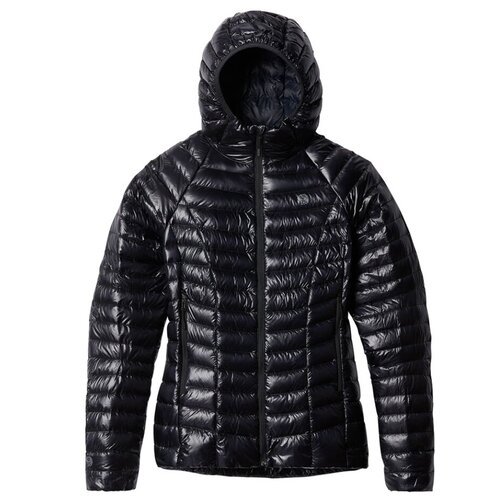
Two leading contenders in the world of trekking jackets are the Arc’teryx Cerium LT and Mountain Hardwear Ghost. Each offers distinct advantages, catering to different needs and preferences. Whichever you lean towards, both these jackets are a testament to the significance of quality in ensuring safety and comfort during treks.
Approach to Choosing the Ideal Jacket
Adapting to Varied Conditions
In Nepal, a single day can encompass freezing mornings, warm afternoons, and chilling evenings. Add to this the sudden onset of rain or snow, and you understand why adaptability is crucial. Jackets that offer excellent warmth-to-weight ratios, such as lightweight down jackets, are ideal for these scenarios.
Weathering Wet Conditions
Nepal’s unpredictable weather means you need a jacket that can handle moisture. Traditional down jackets falter in wet conditions. In contrast, jackets with synthetic insulation, like the Mountain Hardwear Ghost, retain warmth even when damp, making them invaluable in unexpected showers.
Layering and Versatility
Trekkers need a flexible approach to dressing as they move through Nepal’s altitudinal zones. Jackets that can be efficiently layered, whether padded or down, are indispensable. Their adaptability ensures you can navigate through Nepal’s diverse terrain with ease.
Ethics and Environmental Responsibility
Nepal’s respect for nature is profound. As such, trekkers need jackets that align with these values. Jackets that come with certifications like RDS (Responsible Down Standard) assure travelers that their gear has been sourced responsibly.
Features of Types of Jacket
- Down Jackets: Ideal for cold conditions, providing optimum warmth without adding bulk.
- Padded Jackets: Perfect for wet conditions due to their synthetic insulation which retains warmth when damp.
- Ethically Sourced Jackets: Jackets that align with ethical standards, ensuring minimal environmental impact.
- Layering Gear: Items designed to enhance the efficiency of your jacket, offering adaptability across different conditions.
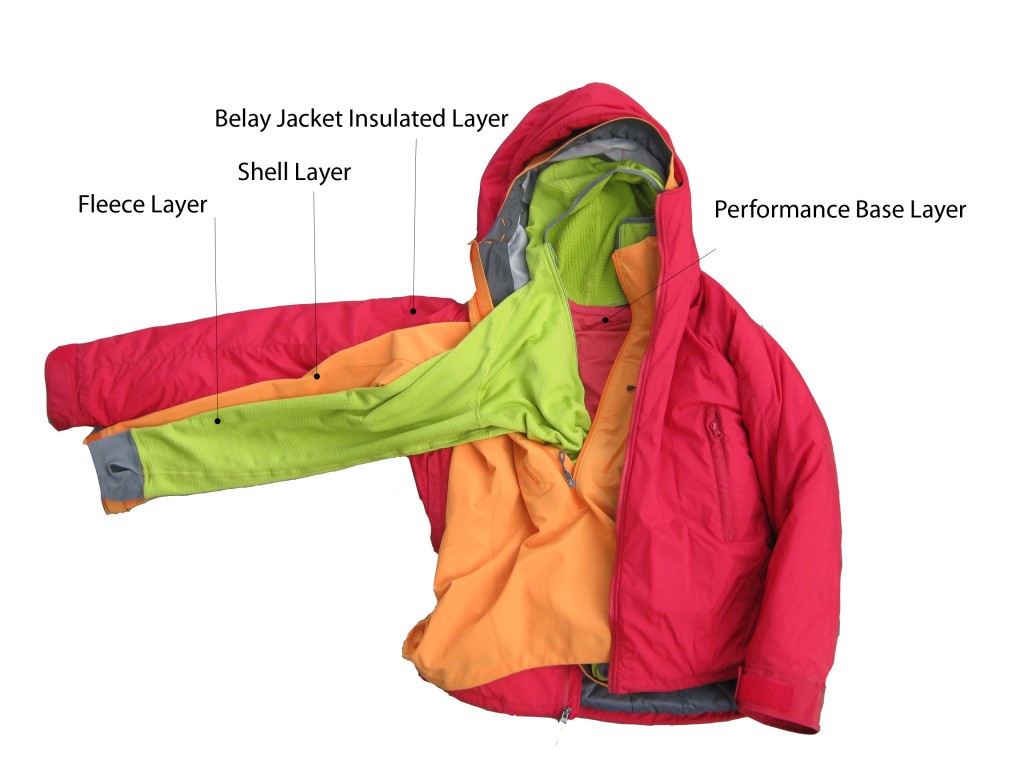
FAQs
Which jacket is better for extremely cold conditions?
Down jackets, like the Arc’teryx Cerium LT, are more suitable for extreme cold due to their superior warmth-to-weight ratios.
What should I opt for if I’m expecting rain during my trek?
Jackets with synthetic insulation, like the Mountain Hardwear Ghost, are recommended as they retain warmth even when damp.
How important is ethical sourcing in trekking jackets?
Ethical sourcing is vital, especially in regions like Nepal which have a deep respect for nature. Jackets with RDS certification ensure responsible sourcing.
Can both down and padded jackets be layered?
Yes, both a down jacket and a padded jacket can be effectively layered to adjust to varying conditions.
Is the longevity of the jacket a significant factor to consider?
Absolutely. Given the demands of trekking in Nepal, you’ll need a jacket that withstands rugged terrains and challenging conditions.
Conclusion
Your trekking jacket is more than just apparel; it’s a companion for your journey. It ensures safety, comfort, and adaptability as you explore Nepal’s captivating landscapes. With the right choice, you’re not just investing in a piece of clothing, but in an enhanced, unforgettable Nepalese adventure.
You may also Like

